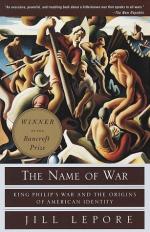
|
| Name: _________________________ | Period: ___________________ |
This test consists of 5 multiple choice questions, 5 short answer questions, and 10 short essay questions.
Multiple Choice Questions
1. Where was Bartholomew de Las Casas born?
(a) France.
(b) Greece.
(c) Seville.
(d) London.
2. Which tribe of Native Americans, in the 17th century, inhabited much of what is now Connecticut?
(a) The Blackfoot people.
(b) The Cherokee people.
(c) The Pequot people.
(d) The Ouachita people.
3. When was Benjamin Church born?
(a) 1701.
(b) 1639.
(c) 1616.
(d) 1689.
4. When did Mary Rowlandson's family move to Lancaster, Massachusetts?
(a) 1612.
(b) 1648.
(c) 1642.
(d) 1653.
5. Where was Metamora; or, The Last of the Wampanoags originally performed?
(a) The Metropolitan Playhouse in New York City.
(b) Carnegie Hall in New York City.
(c) The Park Theater in New York City.
(d) The Boston Globe Theater.
Short Answer Questions
1. Jill Lepore's book, New York Burning: Liberty, Slavery and Conspiracy in Eighteenth-Century Manhattan, was a finalist for what award?
2. The Mohawk people are the most easterly tribe of what confederation?
3. How many children of Mary Rowlandson's were among the hostages taken by Native Americans?
4. Mary Rowlandson was the fifth of how many children?
5. The rock on the shore of Mount Hope Bay translates from Cherokee to say what in English?
Short Essay Questions
1. How does the author describe the aftermath of the war for the Indians in Part Four, Memory, Chapter 7, That Blasphemous Leviathan? What was the cause of the majority of deaths in the war?
2. How was Edwin Forrest's portrayal of Metamora received in England? What does the author write of this in Part Four, Memory, Chapter 8, The Curse of Metamora?
3. How does the author describe Mary Rowlandson's perspective of captivity in Part Three, Bondage, Chapter 5, Come Go Along with Us?
4. What does the author conclude regarding American identity in the Epilogue, The Rock?
5. What does the author write regarding the legend of King Philip and our perception of him through the eyes of history?
6. When was the play Metamora first presented? How was it received?
7. How is the relationship between the Indians and the colonists described in 1681 in Part Four, Memory, Chapter 7, That Blasphemous Leviathan?
8. When was the rock thought to have been engraved in the Epilogue, The Rock?
9. How is the Indian slave trade described in Part Three, Bondage, Chapter 6, A Dangerous Merchandise?
10. What did critics say of the play Metamora? Who supported the play as propaganda for Indian Removal?
|
This section contains 893 words (approx. 3 pages at 300 words per page) |

|




